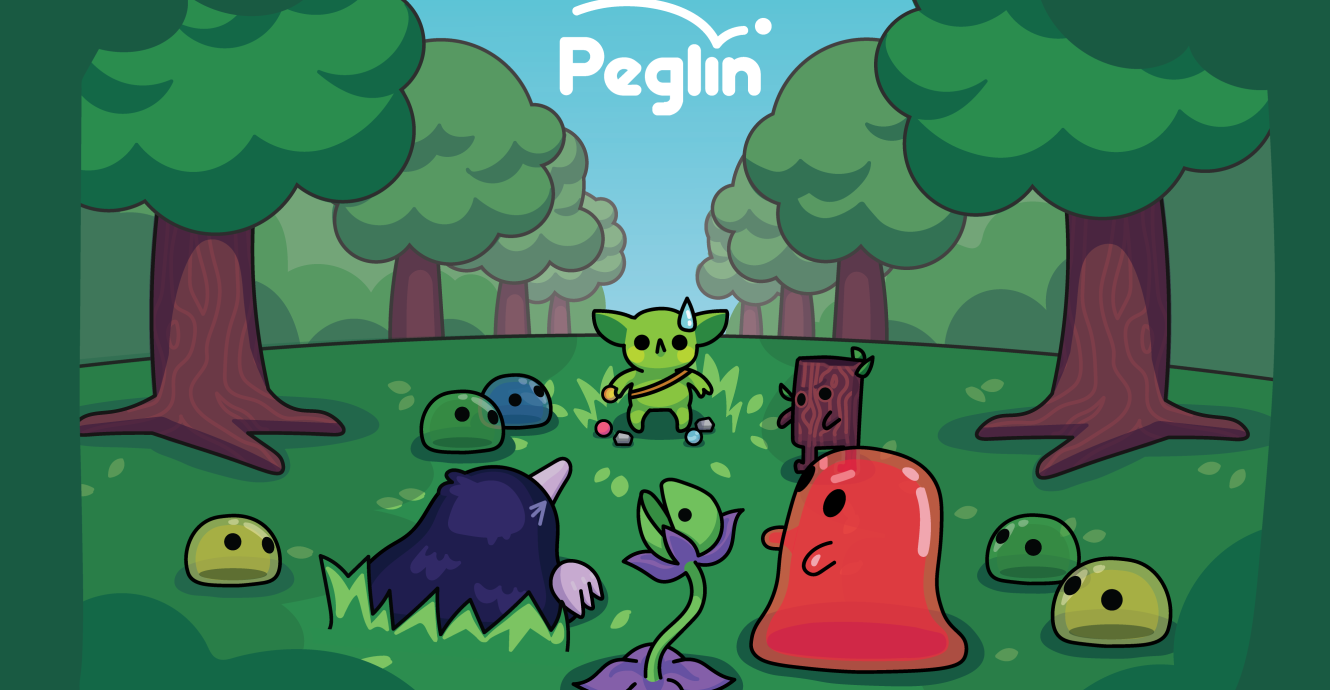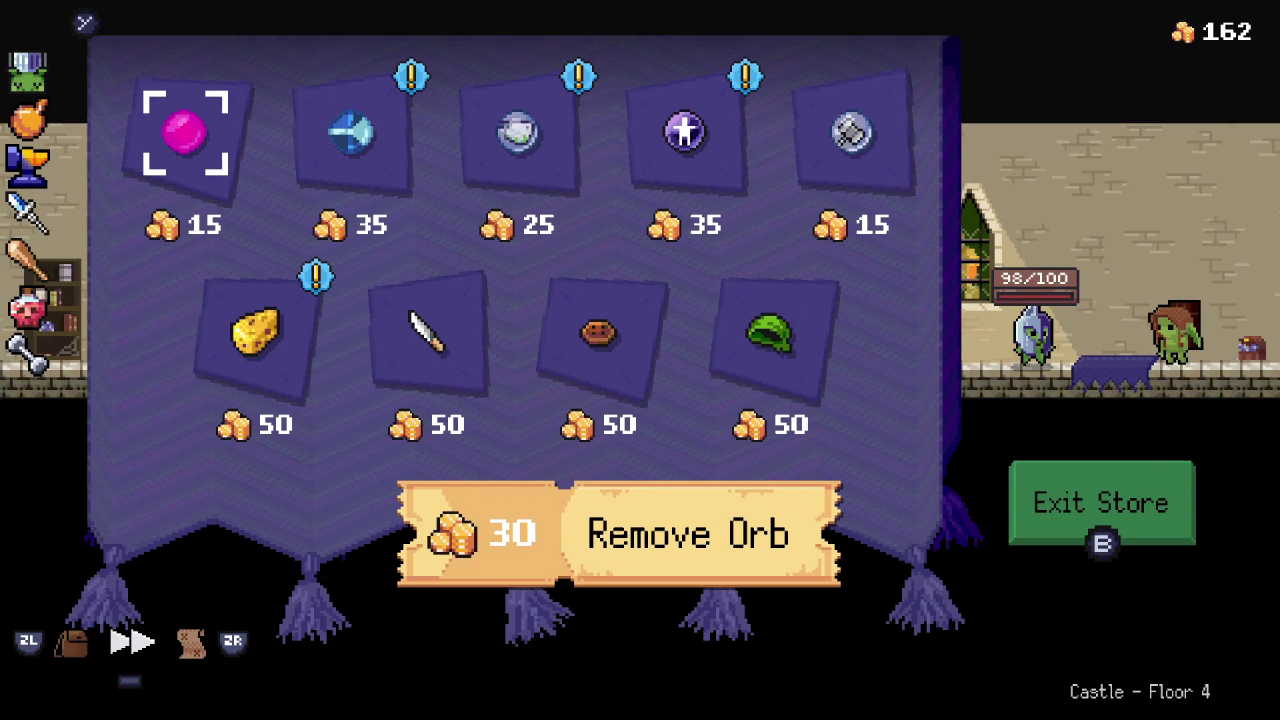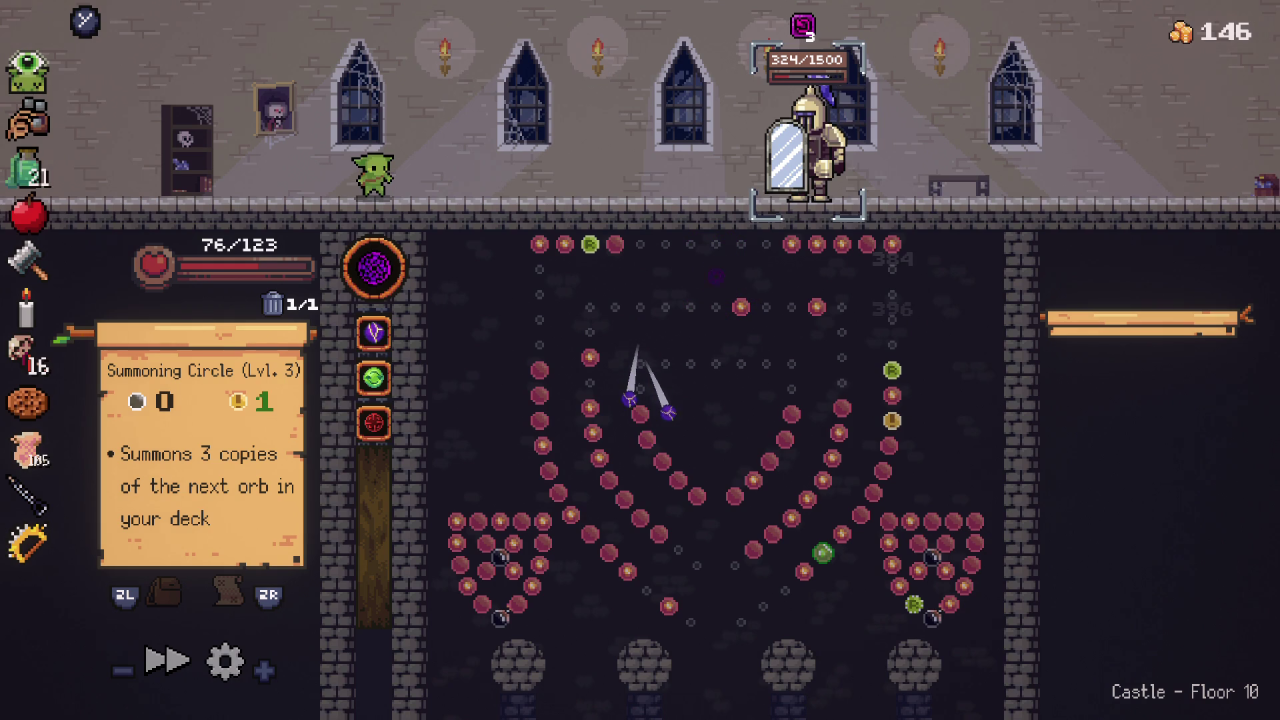Hey, remember Peggle? It’s back. In roguelite RPG form, courtesy of Peglin, developed by Red Nexus Games. While I generally try my hardest to avoid reducing my descriptions of games down to simple “it’s this crossed with this” statements, it’s pretty unavoidable here, and if anything, I think it’s actually a pretty appealing elevator pitch. If you don’t remember Peggle (we aren’t far off the 20th anniversary of it, somehow), here’s as succinct a summary I can offer: a combination of pachinko machines and the arcade classic Breakout, your sole goal was to launch balls from the top of the screen and take out all of the orange pegs on a board within a designated amount of tries. Physics-based goofiness was the name of the game, with the player needing to find the correct angles and pieces to bounce their ball off of to clear a level, and when you DID clear a level, you were rewarded with dramatic, slowed-down closeups of your triumphant ball hitting the last peg, set to Ode to Joy and adorned with rainbows and unicorns and the words “Extreme Fever” emblazoned across your screen.
Peggle was silly, fun, addictive, the right amount of twee for 2007, and most importantly, a pretty cherished relic of a different time in the gaming industry. And while I’m sure there are probably numerous Peggle-likes adorning the bleak, dark depths of Steam, it feels like nothing in the space has really broken through in any meaningful way until now. In the way that Peggle feels like a product that could have only emerged from the mid-2000s, Peglin feels like it could only exist in this current gaming landscape, where it feels like an immeasurable amount of independently-made, roguelite spiritual successors to games that were popular 20 years ago hit the various video game digital shopfronts every week. This isn’t a complaint, mind you; some of my favourite games over the last few years have been roguelites, and there’s nothing more cosy to me than sinking my teeth into a new one on my Switch for dozens (if not hundreds!) of hours. And surprisingly, despite the simple setup, there is a lot to sink your teeth into when it comes to Peglin. Yes, at its core, it’s still a game where you’re throwing balls (or orbs, per the nomenclature of this game) down a pachinko board, activating pegs with various effects along the way to try and clear levels, but there’s a genuine depth here that I was not expecting going in.
Instead of clearing specific pegs to complete a level, your goal in Peglin is actually to defeat all of the enemies in a stage before moving on, and hitting pegs on a board adds to the damage (or other effects!) of the orb that you’re throwing that turn. There are dozens upon dozens of different orbs, the vast majority of which have unique effects. Take the multiball effect, for instance—when you launch your orb and hit a peg, the orb pops another orb into existence, doubling the potential amount of pegs you can activate that turn. And that’s just at level one; most orbs can be upgraded up to level 3, and in the case of an orb with the multiball status, upgrading it might increase not only its damage output but also the amount of orbs that pop into existence when the multiball effect is activated.
And this is a relatively straightforward ability to explain, compared to orbs that might add random effects to every fifth peg they hit on the way down but do no damage that turn, or an orb that shoots like a laser through without bouncing off of most types of pegs and can clear entire boards in one fell swoop and do thousands of damage if you angle it right. Add in all the different effects that pegs can have, relics that passively affect your stats, status effects that can either help or hinder, an entire bestiary’s worth of enemies (including normal ones, minibosses, and bosses), even unique mechanics and hazards on the pachinko boards themselves, and it can get downright overwhelming at times, especially when you try to consider how all of these different elements can coexist and play off of each other. I’m nearing 20 hours into the game and have cleared it multiple times, and I’m still encountering new variations of basically every mechanic I just listed. I actually encountered a bit of frustration on a recent run due to all of this, as I was running what felt like an essentially unstoppable defensive build that was mostly focused around building up a lot of armour on myself very quickly, only to have those dreams shattered at a boss in world 2, a demon wall I had never encountered before that, when it gets close enough to you after a certain amount of turns, will just one shot you and end your run, your amount of armour be damned.
This is, of course, a part of the appeal of roguelites: repeated failures eventually turning into only occasional ones as you steadily familiarise yourself with the game’s intricacies and rules. I’ve put thousands of hours into both Spelunky and Spelunky 2, and I accept that I will never be able to beat a run of either of those games with 100% consistency. The problem I’ve run into specifically with Peglin is twofold. For one, the amount of objects and items and enemies and statuses and encounters, etc. can be a lot to commit to memory, though I concede that that issue can be overcome simply by playing more (perhaps a lot more). My bigger issue, though, and one I’m not yet sure that dedicating more time to the game can solve, is that due to the pure amount of stuff in this game, not all runs are created equal, and in fact, in my time with the game, there can be quite a massive disparity between them at times.
Like with the demon wall example above, there are times where it feels like my build simply cannot make it through the task at hand, no matter what I do. In my time with the game, a build where I can get a decent amount of upgrades related to the bomb pegs on the board feels almost like cheating, whereas I’ve tried multiple times to pull a spinfection (Peglin’s equivalent of poison) build off, only to be met with an insurmountable wall, demon or not, usually in the form of a boss in world 2. Again, I concede that this may simply boil down to my pool of knowledge with the game’s mechanics being simply too shallow, but I’m not someone to usually complain about RNG or randomness in a game, and this feels like it’s strayed just a smidge too far into the random side of the fence for my preferences.
With that all said, it’s hard to complain too much when a good run can feel really damn good. Certain runs have made me feel downright devious, cackling my way to the end of run stats screen after setting off 16 red bombs with one ball lightning orb and obliterating the entire screen in one turn on the final boss. Worth noting is the absolutely lovely presentation. The characters range from simplistic and cute, especially your naked little peglin (peg-goblin, I suppose?), to intricately detailed in a way that reminds me of old 16-bit era Super Nintendo RPG boss sprites. I feel the need to re-emphasise just how much stuff is in the game, so the fact that so much love and care was put into the art of the game is impressive. Just as impressive and fun is the soundtrack, which was decidedly not at all what I was expecting it to sound like, but no less delightful. While the game’s visual aesthetic is framed as mediaeval fantasy dungeon crawling, the soundtrack often strays weirdly far into surfer rock territory, and after spending so much time with the game, I wouldn’t have it any other way.
Peglin probably isn’t going to change your views on art or existence, but as a roguelite successor to Peggle, it accomplishes exactly what it needs to. The surprising amount of depth on offer here might be intimidating to more casual players, but stick with it and you’ll be rewarded with a very addictive (and unique!) entry into the roguelite space.
Release Date:
August 27th, 2024
Platforms:
Nintendo Switch & PC
Price:
£17.99 (NSW)
£16.75 (Steam)
Version Tested:
Nintendo Switch
Many thanks to the developer for the review copy.











Comments
⚠️ Comments for this post are closed ⚠️